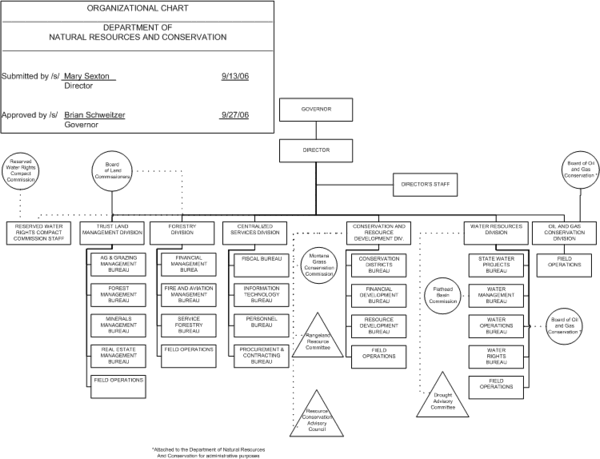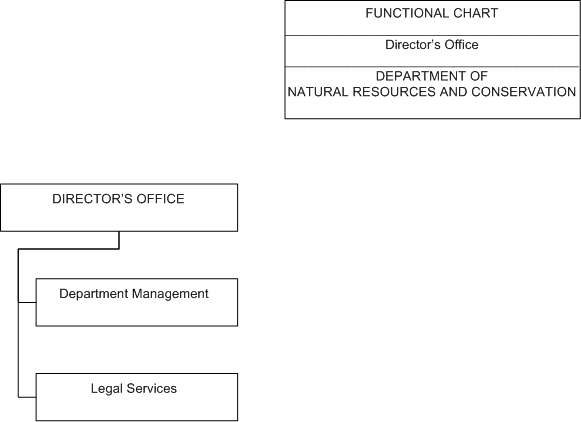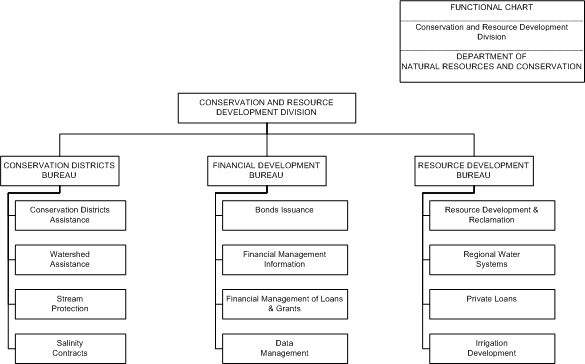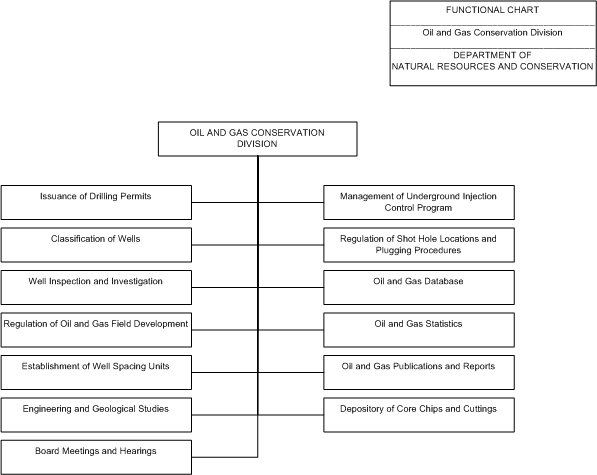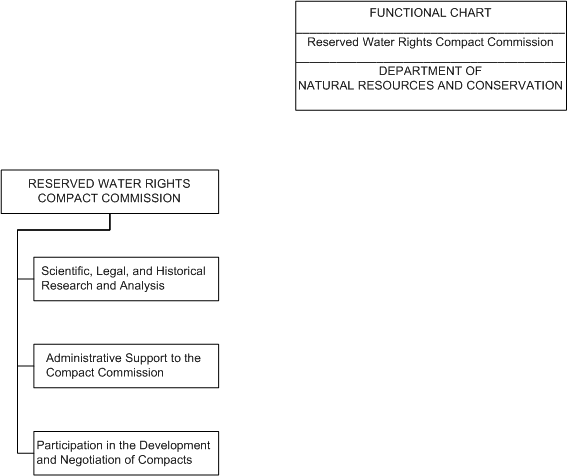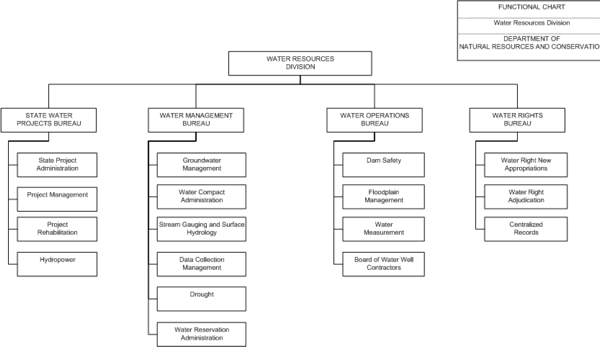
| HOME | SEARCH | ABOUT US | CONTACT US | HELP | ||
| |
| This is an obsolete version of the rule. Please click on the rule number to view the current version. |
|
36.1.101 ORGANIZATION OF DEPARTMENT (1) The organization and functions of the department of natural RESOURCES AND CONSERVATION and its related boards, commissions, and advisory councils are described in this rule. (2) History . The department of natural RESOURCES AND CONSERVATION was established under the Executive Reorganization Act of 1971 by executive order of the governor on December 20, 1971. It was extensively reorganized by the 1995 Legislature. (3) Mission . The department of natural RESOURCES AND CONSERVATION has a mission to help ensure Montana's land and water RESOURCES provide benefits for present and future generations. The department directs a wide variety of programs in meeting these and related goals and objectives. The department is provided for in Section 2-15-3301, MCA. (4) Listing of organizational units . The department is divided into the organizational units listed below. The various boards, commissions, and advisory councils are also listed, although they are not subunits of the department. (a) Director's office . (b) DIVISIONs . (i) Central management DIVISION (ii) Conservation and resource development DIVISION (iii) Forestry DIVISION (iv) Trust land management DIVISION (v) Oil and gas conservation DIVISION (vi) Reserved water rights compact commission staff (vii) Water RESOURCES DIVISION (c) Boards and commissions . (i) Board of land commissioners (ii) Board of oil and gas conservation (iii) Board of water well CONTRACTORS (iv) Montana reserved water rights compact commission (d) Advisory councils . The four advisory councils listed below are directly involved in oversight, review, and/or recommendations on department programs. (i) Rangeland resource executive committee (ii) Resource conservation advisory council (also serves as the soil survey advisory council) (iii) State water plan advisory council (vi) Drought advisory committee These councils have no rule-making or adjudicatory authority. (5) Structure, objectives, and functions of organizational units . (a) Director's office . The director is appointed by the governor and heads the department of natural RESOURCES AND CONSERVATION. The director's office is responsible for overall administration and all policy decisions and recommendations within the purview of the department. (b) DIVISIONs . Each DIVISION is headed by an administrator with line authority over DIVISION personnel. Some DIVISIONs are further broken into bureaus (see attached organization chart) , and some have established field offices in various Montana communities. The DIVISIONs have no rule-making or adjudicatory functions, except as delegated by the director. (i) Central management DIVISION . The objective of the central management DIVISION is to provide support services essential to the effective operation of the department. Areas of responsibility include management of financial activities, management and coordination of information systems, production and coordination of publications and graphic materials, and general administrative support services. (ii) Conservation and resource development DIVISION . The DIVISION provides supervision, coordination, and assists Montana's 59 soil and water conservation districts and 30 state grazing districts in their efforts to protect Montana's natural RESOURCES. The DIVISION is responsible for providing guidance and technical assistance to districts in their work to encourage proper land use practices. The districts establish programs that will prevent soil erosion, minimize saline seep, control noxious weeds, maintain water quality, prevent floodwater and sediment damage, assist rural economic development, provide watershed and rangeland management, and assist with development, use, and disposal of water. The DIVISION implements the state rangeland resource program, administers loans to qualified farmers and ranchers under the rangeland improvement loan program, and provides grants to qualified conservation districts under the 223 program. Through the water development program and the renewable resource development program, the DIVISION awards loans and grants for projects that develop, maintain, or improve water and other renewable RESOURCES. Through the reclamation and development grants program, the DIVISION provides resource indemnity trust interest income for grants for projects that provide reclamation or ensure the quality of public RESOURCES. (iii) Forestry DIVISION . The forestry DIVISION is responsible for the protection of the state's forest and nonforest watershed lands from wildfire, forestry assistance, and regulation of forest practices and wildfire hazards created by logging or other forest management operations on private lands. (iv) Trust land management DIVISION . The trust land management DIVISION is responsible for managing the surface and mineral RESOURCES of forested, grazing, agricultural, and other classified state trust lands to produce revenue for the benefit of Montana's public schools and other endowed institutions. (v) Oil and gas conservation division . The oil and gas conservation division is attached to the department for administrative purposes only; its overall supervision and program direction come from the board of oil and gas conservation. The objectives of the oil and gas conservation division are to prevent waste and provide for the conservation of crude oil and natural gas through regulation of exploration and production activities. The division's activities include issuance of drilling permits, regulation of drilling and production, classification of wells, well injections and investigations, regulation of the location of geophysical exploration and the plugging of shot holes, engineering studies, maintenance of a depository of core chips and cuttings, and regulation of underground injection control (subject to U.S. environmental protection agency approval) . (vi) Reserved water rights compact commission staff . The reserved water rights compact commission and staff water rights compact commission staff is to provide support services essential to the effective negotiation of compacts by the reserved water rights compact commission. The staff's technical activities include historical and legal research, analyses of soils, vegetation, land-use, and hydrology, and analyses of economic and engineering feasibility. (vii) Water resources division . The objectives of the water resources division are to sustain and increase the benefits Montana derives from water resources and to minimize water-related damage and loss. The division helps formulate and recommends water policy and provides interstate coordination of water issues. The division is responsible for the administration of state-owned water resource projects, water rights, and water reservations. Its activities include state centralized water rights record-keeping, permitting authority for new water uses, providing assistance to the water court in adjudicating pre-1973 water rights, state water planning, dam safety, retrofitting state-owned water projects with hydropower facilities, floodplain management, weather modification, drought planning and mitigation, and water allocation compacts. The division also provides support to the board of water well contractors. (c) Boards and commissions . (i) Board of land commissioners . Under the constitution and the statutes, administration of the state trust land in Montana by the department is subject to the review and approval of the board of land commissioners. The director is responsible, under the direction of the board for the administration of state trust land management functions vested in the department. (ii) Board of oil and gas conservation . The board of oil and gas conservation consists of seven members appointed by the governor for four year terms. The board is attached to the department for administrative purposes only; it makes substantive decisions separately from the department and the operations of the oil and gas conservation DIVISION. Responsibilities of the board of oil and gas conservation include promoting conservation of oil and gas and preventing waste, contamination, and damage to land and underground strata from oil and gas activities. It establishes well spacing units and protects the correlative rights of mineral owners. It regulates all Class II (oil and gas) injection wells (subject to approval by the U.S. environmental protection agency) . The board also adopts administrative rules and orders. (iii) Board of water well contractors . The board of water well contractors consists of five members and is attached to the department for administrative purposes. Three of the members are appointed by the directors of their respective agencies for indefinite terms, and two of the members, who are appointed by the governor, represent the water well industry. The board of water well contractors adopts administrative rules regulating licenses and establishing minimum construction standards for water wells and monitoring wells. The board inspects wells upon request or complaint, and at other times as deemed necessary. The board also licenses well drillers, contractors, and monitoring well constructors. (iv) Montana reserved water rights compact commission . The Montana reserved water rights compact commission is attached to the department and the commission's staff is a principal unit of the department. The nine commission members, who are to serve until the commission's work is completed, are appointed as follows: four by the governor, two by the president of the Montana senate, two by the speaker of the Montana house, and one by the attorney general. The Montana reserved water rights compact commission is part of the statewide stream adjudication. The commission negotiates compacts to quantify the federal reserved water rights of the Indian tribes and federal agencies located in the state of Montana. It has no rule-making or adjudicatory authority. (6) Information and submissions . General inquiries regarding the department, boards, commission, or advisory councils may be addressed to the director. Specific inquiries regarding the functions of a division may be addressed to the administrator of that division. All requests for department policy, hearings, declaratory rulings, and participation in rule-making should be addressed to the director unless the notice in the Montana Administrative Register makes specific provisions for submissions. (7) Personnel roster . Following are addresses of key officials of the department of natural Resources and Conservation, boards, and commission. If no address is given after the name, that official can be reached by writing to the Department of Natural Resources and Conservation, 1625 Eleventh Avenue, Helena, Montana 59620-1601. (a) Department officials . (i) Director . (ii) Information officer . (iii) Personnel officer . (iv) Chief legal counsel . (v) Administrator, central management division . (vi) Administrator, conservation and resource development division . (vii) Administrator, forestry division, Department of Natural Resources and Conservation, 2705 Spurgin Road, Missoula, Montana 59801-3199. (viii) Administrator, trust land management division . (ix) Administrator, oil and gas conservation division , Department of Natural Resources and Conservation, 2535 St. Johns Avenue, Billings, Montana 59102. (x) Program manager, Montana reserved water rights compact commission staff . (xi) Administrator, water resources division . (b) Officials of boards and commission . (i) Chair, board of land commissioners . (ii) Chair, board of oil and gas conservation. (iii) Program manager, board of water well contractors . (iv) Chair, Montana reserved water rights compact commission . (8) Charts of department of natural resources and conservation . Descriptive organization and functional charts of the department of natural resources and conservation are attached as the following eight pages of this rule and by this reference are herein incorporated. �
�
�
�
�
�
History: 2-4-201, MCA; IMP, 2-4-201, MCA; Eff. 12/31/72; AMD, Eff. 7/5/73; AMD, Eff. 4/15/74; AMD, Eff. 12/5/74; AMD, Eff. 10/5/75; AMD, Eff. 10/24/77; AMD, Eff. 7/27/78; AMD, Eff. 7/2/79; AMD, Eff. 3/31/80; AMD, Eff. 7/1/81; AMD, Eff. 4/82; AMD, Eff. 9/30/88; AMD, Eff. 9/30/90; AMD, Eff. 7/1/95. |
A directory of state agencies is available online at http://www.mt.gov/govt/agencylisting.asp.
For questions about the organization of the ARM or this web site, contact [email protected].
